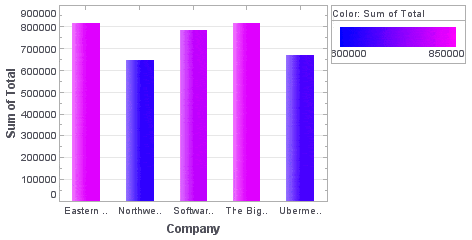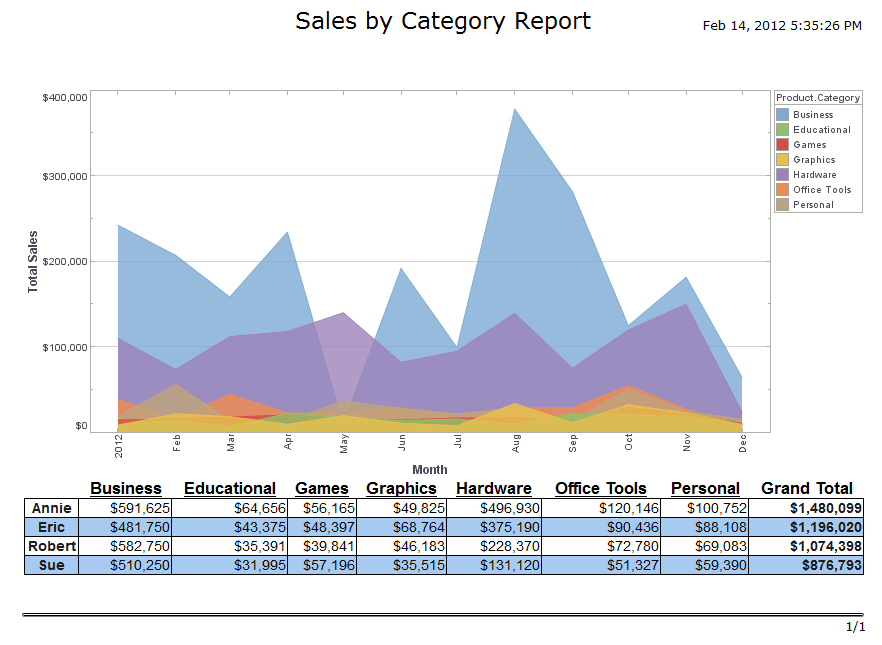InetSoft Webinar: Implementing Strategic Reporting Analysis Programs
This is the continuation of the transcript of a Webinar hosted by InetSoft in February 2012 on the topic of "Business Intelligence Agility" The speaker is Mark Flaherty, CMO at InetSoft.
 We received a
very interesting question from one of our audience members that asks, what are the smallest businesses that
you see implementing strategic reporting analysis programs and what are the primary obstacles that those small
businesses traditionally have faced?
We received a
very interesting question from one of our audience members that asks, what are the smallest businesses that
you see implementing strategic reporting analysis programs and what are the primary obstacles that those small
businesses traditionally have faced?
Even a small business needs to have some number they track. An independent is the smallest possible, one guy working out of his house and he should still have a balanced scorecard in his business. He doesn’t need balanced scorecard software, but he can have a scorecard that he keeps track of. He can track things like how many people attend webinars like this. Or book sales might be leading indicator, because he can get 100 people that buy his book, ten might read it and one might call him and he might get a consulting gig out of it.
So, the big obstacle to doing this in a small company is that most of the data you’re gathering is via observation and asking questions because you’re the owner, you’re also the busboy, and you’re also the accountant. Maybe you’re the salesman, the guy that manages the vendors. So you don’t really need to go to a lot of meetings to see what’s going on because you’re right in there doing it. So I think that’s an obstacle, and I think people that are in those roles, where they are really in touch with a lot of what’s going on in their company, they tend not to need a lot of numbers or statistics on things
 |
View a 2-minute demonstration of InetSoft's easy, agile, and robust BI software. |
 The problem with that though is just relying on your eyes and ears as data is that people act
different knowing you’re the boss, and so they are going to put on their best front when you’re
watching, and you may not see what’s really going on in your organization once you leave, so you
probably do need some numbers too. A big barrier in a small company is finding the money to do this, to go out
and buy some software and finding the time to collect these numbers and have meetings and so forth.
The problem with that though is just relying on your eyes and ears as data is that people act
different knowing you’re the boss, and so they are going to put on their best front when you’re
watching, and you may not see what’s really going on in your organization once you leave, so you
probably do need some numbers too. A big barrier in a small company is finding the money to do this, to go out
and buy some software and finding the time to collect these numbers and have meetings and so forth.
Next question, how do you convince detail oriented managers to agree with a index metrics?
That’s an excellent question, and I often run into those types of managers, and the answer is you don’t convince them, but usually you can get them to agree that nobody can manage 50 or 100 variables, it’s impossible. So, they can agree with that, but they need to have that kind of detail to feel comfortable, to make sure they are not being snowed and so forth.
What I tell them is that you’re going to have all that detail, but it’s going to be stacked into layers for you. So, at the very top of your scorecard you’re going to have 16 measures and underneath each one of those 16 there will be three to four sub measures, and underneath each one of those there’ll be three to four and so forth.
Some dashboarding software has a feature I call an idiot light where if the Tier 1 gauge is green, but you’ve got a little tumor growing somewhere, the idiot light will flash red. What it’ll tell you is that somewhere in your organization you have a little problem that needs to be addressed and it may be seven layers down. It may be that location that you have in Albequerque, and it’s a small office, but they are having some kind of a problem.
So by having that warning light on the dashboard, that prevents the detail oriented managers from having to look at 300 or 400 charts to see what’s going on, and it allows them to drill down to find out exactly where is the problem. So that’s usually how I convince them that you can manage an organization as big and complex by having 15 or 20 high level measures because there is a lot of intelligence underneath each one of those measures.
Next question, how do you combine unlike units of measure into a single number?
You have to convert everything to some unit of 0 to 100 or 0 to 10. You’d have to take something like your weight in pounds and say what would a 10 be, if a 10 is good and you’d have to take your cholesterol which is in milligrams and measure that and say what would be a 10? So if your cholesterol is 200 or less, that might be a 10 and if it’s 400 or more, that might be a 1.
So that’s how you do this is you take each one of the individual numbers and you put it on a scale from 1 to 10 or 0 to 100, and then you can take all these things. Once you’ve programmed that into the software, it can take the raw data; your cholesterol, your resting heart rate, your weight, whatever that raw data is, and it’ll perform these calculations on them without you doing any work and convert it into the index.
So the people that construct the index have to build all this intelligence into it, so that’s basically how it’s done, and that’s why sometimes these projects take a little bit of time because you want to really think through it and get it right and put the right weight on each one of the factors.
So in the measure, I gave you an example, realage.com, 30 per cent of weight is given to genetics and a much higher weight; 40 to 50 per cent is given to lifestyle. You can’t do anything about your genetics even though they are a factor but you can do a lot about lifestyle.
| Previous: Good Performance Management Techniques |